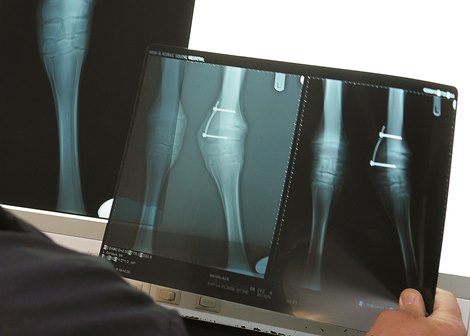New analysis from the Royal Veterinary School (RVC) has recognized greater than 100 genes that will contribute to bone fracture danger in Thoroughbreds. These findings will inform additional analysis into genetic danger components, contributing to well being and well-being efforts and supporting the event of novel interventions to cut back fracture danger in horses.
Bone fractures are widespread in Thoroughbred racehorses, as a result of forces the bones can expertise. Bone fractures are sadly a number one reason for euthanasia, with roughly 60 horses having to be euthanised on UK racecourses every year. Nevertheless, fractures are a fancy situation, with each environmental and genetic danger components affecting a horse’s susceptibility.
Led by Dr Debbie Visitor, Senior Analysis Fellow on the RVC, a workforce of researchers used a polygenic danger rating for fracture danger to determine a brand new mannequin with stem cells to make bone-forming cells from horses at each excessive and low danger. The workforce measured each gene that was expressed by the cells to establish these with completely different expression ranges within the bone cells from horses at larger versus these at decrease danger.
The research recognized 112 genes that could be concerned in fracture danger and demonstrated that many of those genes regulate the bone matrix. Nevertheless, a lot of the genes have by no means been studied in bone earlier than and extra analysis is required to know the perform of those genes in bone cells and the way they contribute to fracture danger.
That is the second research in a sequence of analysis, exploring genetic mechanisms behind fracture danger. A earlier research discovered that collagen kind III, a gene which is required for regular bone formation, is expressed at decrease ranges in bone cells from horses with a excessive genetic danger of fracture. It’s because they’ve a change of their DNA sequence within the area which controls how a lot collagen III is produced.
Extra analysis is now being performed to validate the risk-scoring system in one other cohort of horses. Additional research utilizing this method and cell mannequin will assist to establish different genes and processes to raised perceive why some horses are inherently extra vulnerable to fracture than others. It will assist veterinary practitioners to raised help and deal with thoroughbreds.
Dr Debbie Visitor, Senior Analysis Fellow on the RVC, stated:
“Bone fractures are a standard downside in Thoroughbred racehorses, regardless of many modifications to racecourses over time to cut back environmental danger components. We all know that fracture danger has a genetic element and we’ve got beforehand developed a polygenic danger rating for fracture to permit us to establish horses at elevated danger.
“On this research, we’ve got recognized many new genes which have altered expression in bone cells from high-risk horses. For a few of these genes, we all know that they play a task in regulating the bone matrix. We will now start to develop a deeper understanding of how bone tissue is altered in high-risk horses and new interventions to cut back their danger”.
The analysis was funded by the Horserace Betting Levy Board, the Anne Duchess of Westminster Charitable Belief and The Alborada Belief.
This press launch has not been edited by BloodHorse. If there are any questions please contact the group that produced the discharge.






